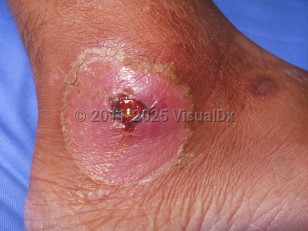Cutaneous diphtheria is caused by
Corynebacterium diphtheriae, a pleomorphic, aerobic, Gram-positive bacillus that causes symptoms through the production of a bacteriophage-dependent exotoxin. Human beings are the only known reservoir for
C diphtheriae, which can only inhabit mucous membranes and skin and is therefore spread by respiratory droplets or contact with the exudate of a diphtheritic cutaneous lesion, including objects contaminated with discharge from the lesion. There are three forms of cutaneous diphtheria:
- Primary infection, which begins as a pustule or vesicle on previously normal skin
- Superinfection of an eczematized lesion
- Secondary infection of a wound
Cutaneous diphtheria typically follows an indolent course, usually remaining local, with few known cases of toxic complications (cardiomyopathy or neuropathy) as seen more frequently with upper respiratory tract diphtheritic infections. However, cutaneous infection is associated with more bacterial shedding and higher rates of transmission of pharyngeal and cutaneous diphtheria to close contacts. The skin is often an importation reservoir for
C diphtheriae and is associated with sporadic cases of respiratory diphtheria; therefore, prompt recognition and treatment of cutaneous diphtheritic infection may reduce environment contamination with
C diphtheriae.
Those at greatest risk for cutaneous diphtheria are people living in impoverished, crowded, unhygienic environments, particularly in the developing world, or immigrants from countries where rates of vaccination with diphtheria toxoid are low. Southeast Asia is a known endemic area, and the disease has been associated with the tropics although it exists in temperate regions as well. There has been a shift in the age demographics of cases occurring in the United States; in the pre-vaccination era it was typically a pediatric problem. Now it is more common in those aged over 15, since this population is less likely to have had the vaccination or adequate boosters.
Related topic:
respiratory diphtheria


